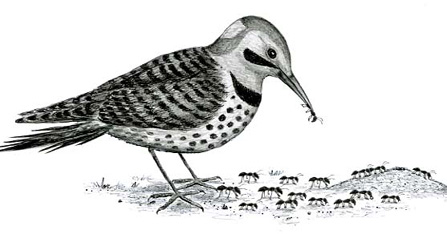
Dear Bird Folks:
We read your column each week, but recently you have been writing about some rather obscure birds. We think you should write about something more common. We would like to know more about flickers. Are they woodpeckers? And if they are woodpeckers, why are they always feeding off the ground instead of trees?
-Tim, Plymouth
“We” Tim,
“We” would like to know? What’s with the we? Are you the leader of an organized group? Is there some kind of flicker club going on there in Plymouth? Gee, I hope it’s not a cult, The Puritans wouldn’t like that. They’ll force you to move to Marshfield. Think about it.
Flickers, eh? I know I’m starting to slip a bit, but didn’t I answer a question about flickers back in April? Yeah, I remember, it was our annual “the woodpeckers are drumming on my house” column. Maybe all of you were at the club meeting and somehow missed it.
Yes, flickers are woodpeckers. I know they don’t have “woodpecker” as part of their name, but they really are woodpeckers, honest. Common names can be tricky. A mallard is still a duck even though it doesn’t have a “duck” in it’s common name. I find that common names are accurate about 20% of the time. The rest of the time they make as much sense as the owners manual for a digital camera.
I know of two theories as to how flickers got their name. One has do to with the gold (the yellow under-wings) that “flicks” into view as the bird flies from tree to tree. The other relates to their call. Flickers have a call that sounds like “flick-a, flick-a, flick-a”. Their name is based on their call. If the flick-a = flicker theory doesn’t make any sense to you Tim, just call up someone from Worcest-a and they’ll explain it to you.
Why is this woodpecker so often found on the ground? It’s the ants. Flickers love ants. They eat more ants than any bird in North America. One flicker was found with over 5,000 ants in its stomach, plus cole slaw and a pickle. A big old nasty ant hill, that freaks us out, is an all you can eat buffet to a flicker. While all of their fellow woodpeckers are smashing their faces into trees, trying to dig out grubs, flickers are sitting in the soft sand lapping up sweet ants. The ants are sweet because they are probably the same ants that have spent the entire morning swimming in your hummingbird feeder.
The bird you see in your yard is properly called “Northern Flicker”. Northern Flickers come in two races. Here in the east we’ve got the “yellow-shafted” race that has the golden under wings. Out west, they have the “red-shafted” race with salmon red under wings. In the middle of the country, where the ranges of the two races overlap, the birds readily interbreed. The interbreeding produces “intergrades”, which are a crazy mixture of both races, that took ornithologists years to sort out.
Flickers are one of the easiest birds to identify. They are big, conspicuous and have a ton of obvious field marks. In addition to the colorful wing linings, they have a spotted chest, a black bib, a white rump patch, plus the traditional red spot on the back of the head, that many of our other woodpeckers have. If you confuse this bird with anything else, you should trade your binoculars in for a white cane.
Unlike the Downy and the Hairy Woodpecker, where only the male bird has the red head spot, both sexes have it on flickers. However, in order to make things easy on bird watchers, the male flicker has a thick black mustache-looking mark on his face. The female flicker has no black mustache and, of course, much better looking legs.
Probably because flickers have opted for eating soft ants on the ground, they haven’t developed the same carpentry skills that the other tree-bound woodpeckers have. Flickers depend on well rotted trees to build their nests in. With well rotted trees being in short supply, flickers usually return to the same nesting tree year after year.
One last note about your bird Tim. The Northern Flicker, strangely enough, happens to be the state bird of Alabama. Only down there it is called the “Yellowhammer”. There is no way Alabamans are going to call their state bird anything with the word “northern” in it.